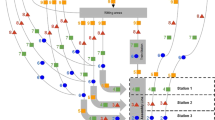Abstract
Assembly lines are cost efficient production systems that mass produce identical products. Due to customer demand, manufacturers use mixed model assembly lines to produce customized products that are not identical. To stay efficient, management decisions for the line such as number of workers and assembly task assignment to stations need to be optimized to increase throughput and decrease cost. In each station, the work to be done depends on the exact product configuration, and is not consistent across all products. In this paper, we propose a mixed model line balancing integer program (IP) that considers parallel workers, zoning, task assignment, and ergonomic constraints with the objective of minimizing the number of workers. Upon observing the limitation of the IP, a Constraint Programming (CP) model is developed to solve larger assembly line balancing problems. Data from an automotive OEM are used to assess the performance of both the MIP and CP models, including sensitivity analysis to measure the computational cost of enabling the different constraints. To the best of our knowledge, we are the first paper to incorporate the different realistic mixed model assembly line constraints and develop a CP model based on the scheduling module of the IBM ILOG Optimizations Studio. Using the OEM data, we show that the CP model outperforms the IP model for bigger problems.












Similar content being viewed by others
References
Baybars, I. (1986). A survey of exact algorithms for the simple assembly line balancing problem. Management Science, 32(8), 909–932.
Becker, C., & Scholl, A. (2006). A survey on problems and methods in generalized assembly line balancing. European Journal of Operational Research, 168(3), 694–715.
Becker, C., & Scholl, A. (2009). Balancing assembly lines with variable parallel workplaces: problem definition and effective solution procedure. European Journal of Operational Research, 199(2), 359–374.
Bockmayr, A., & Pisaruk, N. (2001). Solving assembly line balancing problems by combining IP and CP. In Proceedings of the 6th annual workshop of the ercim working group on constraints. Prague.
Boysen, N., & Fliedner, M. (2008). A versatile algorithm for assembly line balancing. European Journal of Operational Research, 184(1), 39–56.
Boysen, N., Fliedner, M., Scholl, A. (2007). A classification of assembly line balancing problems. European Journal of Operational Research, 183(2), 674–693.
Boysen, N., Fliedner, M., Scholl, A. (2008). Assembly line balancing: which model to use when? International Journal of Production Economics, 111(2), 509–528.
Boysen, N., Fliedner, M., Scholl, A. (2009). Assembly line balancing: joint precedence graphs under high product variety. IIE Transactions, 41(3), 183–193.
Bukchin, Y., & Rabinowitch, I. (2006). A branch-and-bound based solution approach for the mixed-model assembly line-balancing problem for minimizing stations and task duplication costs. European Journal of Operational Research, 174(1), 492–508.
Ege, Y., Azizoglu, M., Ozdemirel, N.E. (2009). Assembly line balancing with station paralleling. Computers & Industrial Engineering, 57(4), 1218–1225.
Erel, E., & Gokcen, H. (1999). Shortest-route formulation of mixed-model assembly line balancing problem. European Journal of Operational Research, 116(1), 194–204.
Falkenauer, E. (2005). Line balancing in the real world. In Proceedings of the international conference on product lifecycle management PLM (Vol. 5, pp. 360–370).
Gökcen, H., & Erel, E. (1997). A goal programming approach to mixed-model assembly line balancing problem. International Journal of Production Economics, 48 (2), 177–185.
Gökcen, H., & Erel, E. (1998). Binary integer formulation for mixed-model assembly line balancing problem. Computers & Industrial Engineering, 34(2), 451–461.
Kara, Y., Özgüven, C., Seçme, N. Y., Chang, C.T. (2011). Multi-objective approaches to balance mixed-model assembly lines for model mixes having precedence conflicts and duplicable common tasks. The International Journal of Advanced Manufacturing Technology, 52(5-8), 725– 737.
Mahdavi, I., Javadi, B., Sahebjamnia, N., Mahdavi-Amiri, N. (2009). A two-phase linear programming methodology for fuzzy multi-objective mixed-model assembly line problem. The International Journal of Advanced Manufacturing Technology, 44(9-10), 1010–1023.
Öztürk, C., Tunal, S., Hnich, B., Örnek, A.M. (2010). Simultaneous balancing and scheduling of flexible mixed model assembly lines with sequence-dependent setup times. Electronic Notes in Discrete Mathematics, 36, 65–72.
Öztürk, C., Tunal, S., Hnich, B., Örnek, A. (2013). Balancing and scheduling of flexible mixed model assembly lines with parallel stations. The International Journal of Advanced Manufacturing Technology, 67(9–12), 2577–2591.
Öztürk, C., Tunal, S., Hnich, B., Örnek, M.A. (2013). Balancing and scheduling of flexible mixed model assembly lines. Constraints, 18(3), 434–469.
Öztürk, C., Tunal, S., Hnich, B., Örnek, A. (2015). Cyclic scheduling of flexible mixed model assembly lines with parallel stations. Journal of Manufacturing Systems, 36(1), 147–158.
Pastor, R., Ferrer, L., García, A. (2007). Evaluating optimization models to solve SALBP. In International conference on computational science and its applications (pp. 791–803). Berlin: Springer.
Pearce, B.W. (2015). A study on general assembly line balancing modeling methods and techniques. Doctoral dissertation: Clemson University.
Pil, F.K., & Holweg, M. (2004). Linking product variety to order-fulfilment strategies. Interfaces, 34, 394–403.
Sawik, T. (2002). Monolithic vs. hierarchical balancing and scheduling of a flexible assembly line. European Journal of Operational Research, 143(1), 115–124.
Scholl, A. (1999). Balancing and sequencing assembly lines, 2nd Edn. Heidelberg: Physica.
Scholl, A., & Becker, C. (2006). State-of-the-art exact and heuristic solution procedures for simple assembly line balancing. European Journal of Operational Research, 168(3), 666–693.
Sewell, E.C., & Jacobson, S.H. (2012). A branch, bound, and remember algorithm for the simple assembly line balancing problem. INFORMS Journal on Computing, 24 (3), 433–442.
Vilà, M., & Pereira, J. (2014). A branch-and-bound algorithm for assembly line worker assignment and balancing problems. Computers & Operations Research, 44, 105–114.
Wilhelm, W.E., & Gadidov, R. (2004). A branch-and-cut approach for a generic multiple-product, assembly-system design problem. INFORMS Journal on Computing, 16(1), 39–55.
Author information
Authors and Affiliations
Corresponding author
Rights and permissions
About this article
Cite this article
Alghazi, A., Kurz, M.E. Mixed model line balancing with parallel stations, zoning constraints, and ergonomics. Constraints 23, 123–153 (2018). https://doi.org/10.1007/s10601-017-9279-9
Published:
Issue Date:
DOI: https://doi.org/10.1007/s10601-017-9279-9




